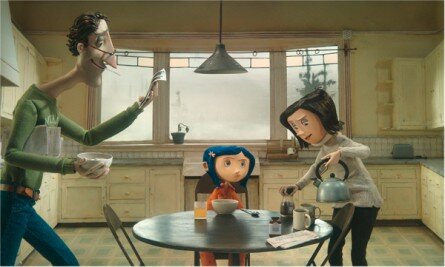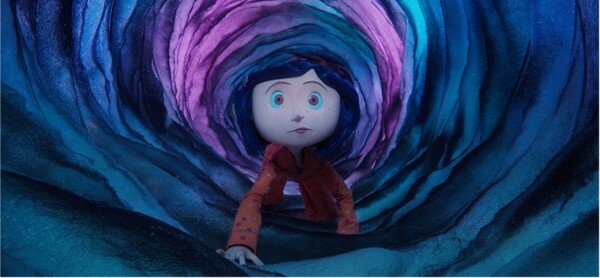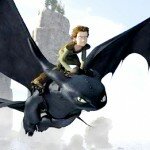The story of Coraline and her fantastical adventures is momentous – but not only because it’s the latest project from The Nightmare Before Christmas director Henry Selick. The film breaks a lot of milestones: at 100 minutes it’s the longest stop-motion feature ever, and the first to be shot entirely in 3D. Not to mention it’s the first venture from animation company LAIKA, and boy do they have big expectations riding on their shoulders with this one. But with the stunning visual experience that comes as we’re taken between what our heroine has and what she thinks she wants, it’s just not the animated masterpiece many were hoping for.
Easy on the eyes through the increasingly familiar glasses, Coraline gives a whimsical feeling of excitement and anticipation. The 3D technique is a triumph as the extra dimension propels you head-first into the story; Coraline’s first discovery of the tunnel connecting her two worlds is particularly beautiful. What’s amazing about stop-motion, when done well, is the intricate detail within the mise-en-scene – strangely enough, nothing is left to the imagination when it comes to the brand of the car or leftover cheese crumbs. That’s reserved for the story itself, full of colour when Coraline discovers her ultimate world and the ‘other parents’ that come with it. The film picks up at this point, where what unfolds leads to the ultimate climax – one of Coraline’s weaknesses is the inconsistent pace which comes and goes throughout the film. It’s disappointing because when it’s good, it’s dark and brooding; or menacing, as the OFLC have labelled it. While these scenes sit side by side with lighter moments, Selick’s ventures surround the darker side of the psyche and it’s great to watch. His version of Coraline’s story (taken from Neil Gaiman’s children’s book) is not for anyone wanting an Ice Age or a Snow White and it intends on delivering messages relevant to adult audiences. With themes of materialism and drawing on the ‘eyes-as-windows-to-the-soul’ theory, Selick’s message isn’t lost in the vessel of a child and refuses to tie every loose end without doubt.

Coraline, as a girl who’s forced to adapt to a new home, is voiced nicely by Dakota Fanning who doesn’t sound her 15 years. She brings the right kind of enchantment to the role, and it’s obvious because of the wonderful facial expressions caught on screen (that make the characters feel so real). Teri Hatcher delivers with promise as Mom and the Other Mother; they are different characters, while genuine feelings go to the impromptu sidekick with animation’s weirdest name: Wybie (voiced by Robert Bailey Jr). Also of note are Absolutely Fabulous duo Jennifer Saunders and Dawn French, who reunite to provide the less tasteful moments of the film. While the impressive voice cast serve the film well, collectively they don’t raise Coraline to great heights. What prevents this from being the Wall-E of 2009 is the lack of exciting action from the get-go and the increasing impression of how long a drawn-out affair it feels.
Verdict
Coraline’s a bit of a mixed bag – kids can enjoy this but they’re not the primary target. Adults can read a lot into it but the pace disallows total immersion in the story. However, there’s no denying the beautiful and effective result of the Real 3D technology.
[Rating: 3.5/5]
 Follow the author Katina Vangopoulos on Twitter.
Follow the author Katina Vangopoulos on Twitter.















